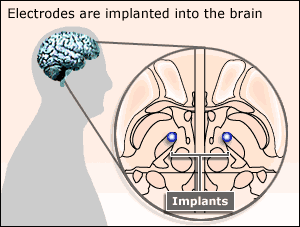 |
|
Fear of contamination Fear of causing harm to another Fear of making a mistake Fear of behaving in a socially unacceptable manner Need for symmetry or exactness |
|
See also: Sep 04 02 Gene for obsessive behaviour May 30 - 02 Religious 'vulnerable to compulsion' Dec 20 - 00 Obsessive-Compulsive Disorder
Internet links:
|
A procedure used to ease symptoms of Parkinson's disease may also help to treat people who suffer from obsessive behaviour.
The technique involves using electrodes to stimulate a specific part of the brain called the subthalamic nucleus.
It has been successfully used to alleviate symptoms in patients with Parkinson's disease.
And researchers in France have found it also helped two patients who had symptoms both of Parkinson's and Obsessive-Compulsive Disorder (OCD).
Obsessive-compulsive disorder is an anxiety disorder in which people are persistently compelled to carry out ritualised behaviour in response to recurring thoughts which are often completely irrational.
For instance, sufferers often become obsessed with the notion that they are contaminated with germs, leading to hour upon hour of washing.
The condition can become so bad that it prevents people from leading a normal life.
Nerve cell circuits
The causes of the disorder, which affects at least five million Americans and a million Britons, are still obscure.
However, it is thought to be associated with alterations to specific nerve cell circuits in the sub-cortical regions of the brain.
One of the patients who underwent treatment had OCD symptoms characterised by obsessive domestic cleaning and a fear of being found dead in a dirty house.
The second patient, who had battled OCD for 40 years, was preoccupied by a checking of locks which took up to three hours a day.
Two weeks after they underwent treatment, both patients showed some improvement in their Parkinson's symptoms.
But their compulsions had completely disappeared, and their obsessive symptoms had also eased.
The researchers say it is possible that the improvement in OCD symptoms could simply be explained by the improvement in Parkinson's symptoms, as people with the disease do tend to show signs of OCD.
However, they think this is unlikely because both patients had OCD several decades before they developed signs of Parkinson's.
They believe it is possible, but unlikely, stimulation with an electrical current may stimulate the release of the brain chemical serotonin, which plays a significant role in controlling mood, and is known to be found in lower levels among OCD patients.
Alternatively, the current may inhibit electrical activity in the subthalamic nucleus, which then has a knock-on impact on other areas of brain involved in the control of the emotions.
Challenging condition
Researcher Professor Yves Agid, from the French Inserm institute, told BBC News Online it was impossible to draw firm conclusions from studies on just two patients.
But he said the technique potentially provided an alternative to more radical forms of neurosurgery which involve burning away, or ablating, parts of the brain.
"We know that there are nerve cell circuits that a linked to control of emotions in structures deep within the brain, and that manipulation, either through drugs or neurosurgery, might help patients with OCD.
"Neurosurgery of this kind using electrical stimulation is reversible, adaptable and does not induce lesions in the brain. There are almost no side effects."
Ian Hancock, director of psychology at Dumfries and Galloway Primary Care NHS Trust, told BBC News Online that most OCD patients could be effectively treated with cognitive behavioural therapy (CBT) techniques.
Unlike the use of implants, this is not an invasive procedure, and not does not require the use of drugs.
He said: "If CBT and an in-patient regime has failed, and the patient is really suffering, then - and only then - should more invasive procedures like implants even begin to be considered.
"That would apply to a very, very small percentage of OCD patients."
The research is published in The Lancet medical journal.